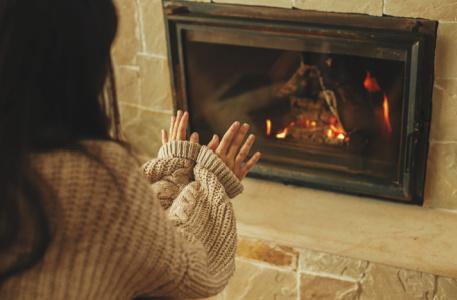
The Pros and Cons of Vented and Ventless Gas Fireplaces
Do you love the ambiance of a flickering fireplace but shy away from the hassle of stocking a wood pile, starting and maintaining a fire, and keeping a fireplace clean? Gas-fueled fireplaces may not perfectly mimic burning wood, but they’ve come a long way and offer numerous benefits.
If you’re leaning toward gas, you still face a long list of decisions starting with how air flows through the unit—the venting system. Generally, gas fireplaces fall into three categories:
Direct vent – A direct vent fireplace has a glass panel that seals off the air in your home from the burning logs. A pair of vents draw in fresh exterior air and release unhealthy emissions outdoors—similar to the way a gas furnace vents away hazardous gases.
Natural vent – A natural vent fireplace (also called a B vent) is intended to vent air in one direction—up and out. Dangerous combustion fumes are exhausted outdoors, but downdrafts can occur, and some of the air within your home may be drawn into the unit too.
Ventless – Some gas fireplaces are designed to operate without any vent. To be used safely, carbon monoxide detectors are also installed to monitor indoor air quality. Due to safety concerns, ventless fireplaces are banned in several states and Canada.
Manufacturers of gas fireplaces offer countless features and enhancements, significantly expanding your options within each category.
Some choices are about personal preferences. (Do you want a fireplace with a remote control?) Other decisions hinge on your installation requirements. (Will you need power venting to facilitate airflow?)
It isn’t easy to make broad generalizations about gas fireplaces, given the range of product options within each category. However, here are five of the most vital considerations and trade-offs.
1. Safety
When installing and operating a gas fireplace, homeowners must be mindful of two vital safety concerns—air quality and fire hazards.
Since direct vent systems are completely sealed off from the rest of your home, they’re typically considered the best option for indoor air quality. However, if you prefer a natural vent or ventless system, ensure it includes air sensors and consider adding a separate backup monitor.
When installing any fireplace, it’s essential to use combustible construction materials carefully. Check your manufacturer’s installation guide for details. For example, there will be restrictions on how close you can place a wood mantle above the fireplace opening and how far it can protrude from the wall.
2. Location
A direct vent fireplace’s exhaust system can run horizontally or vertically, which provides more alternatives for positioning the unit in your home. In contrast, natural vent systems can only exhaust upwards.
Since there’s no need to incorporate ventilation tubing, ventless fireplaces offer the most flexibility and are used in some spaces where it would be impossible to add a vented system.
However, ventless fireplaces are inappropriate in small rooms where carbon monoxide will accumulate faster or spaces where you can’t crack a window to let in some fresh air.
3. Energy efficiency
Direct vent units typically provide the greatest energy efficiency since they use a sealed system. While they don’t draw any air out of your home, most direct vent fireplaces include a variable-speed fan to push heated air back into the house, if desired.
In contrast, a natural vent unit operates more like a traditional fireplace, drawing in some of your home’s air and releasing it through a chimney-like vent. As a result, in addition to reduced energy efficiency, you’ll experience more air leaks than in a sealed, direct vent system.
Finally, with a ventless fireplace, all the heat is released into the room, and no air drafts through a vent. That makes them highly energy efficient. However, running them for long periods is not advisable unless you crack a window to draw in fresh (cold) air, which immediately reduces their energy efficiency.
4. Appearances
The operational differences between vented and ventless fireplaces are primarily hidden from view, but there are some easy ways to tell them apart.
First, a direct vent fireplace will always have a pane of glass in front of the logs and the flames. Usually, a metal screen is installed over the glass to prevent accidentally touching it and scorching your skin.
Natural vent systems don’t require glass to seal off the unit, which gives them an open flame appearance similar to a traditional fireplace.
Both types of vented systems can display tall, realistic flames that wrap around the logs. In contrast, the flames of a ventless fireplace only rise from the gaps between the logs. Also, ventless units require a higher burn temperature which may produce a less realistic blue flame.
Within each type of fireplace, appearances can vary significantly by manufacturer and log set designs. Also, some units incorporate LEDs to mimic the look of glowing embers or help the flames appear brighter.
5. Cost
You’ll find a wide range of prices for gas fireplaces in all three categories. However, when adding a system to your home, you must consider installation and remodeling costs too.
In terms of installation, ventless units are typically the most affordable since you don’t need to cut any holes in your ceiling or exterior walls and build insulated channels for ventilation tubes.
Before committing to any fireplace, thoroughly research manufacturers’ products, find a reputable dealer/installer, and come armed with questions.
Selecting and installing a gas fireplace is not a simple renovation project, but it can significantly enhance your home’s ambiance and provide a valuable supplemental heat source.
